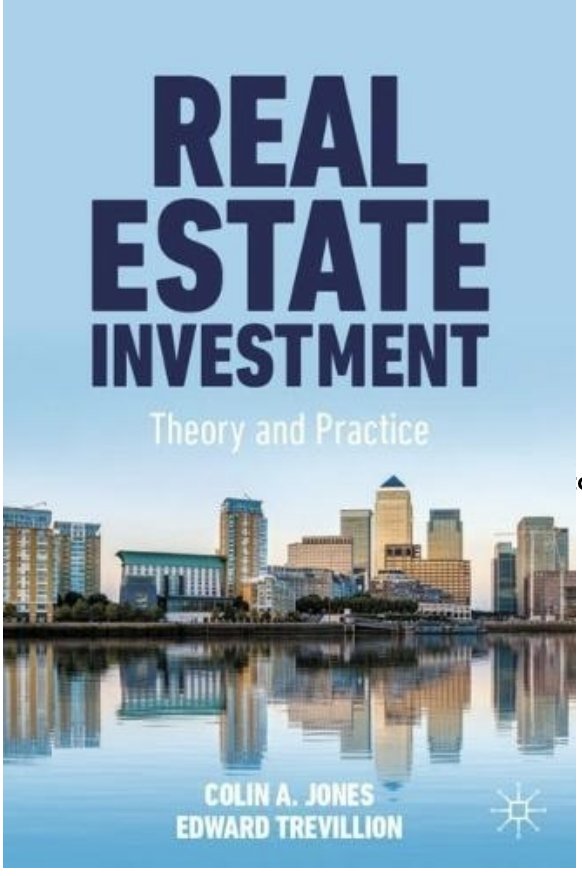An overview of the book by its co-author Edward Trevillion, published by Palgrave Macmillan.
The inspiration for this book came from updating Will Fraser’s text, ‘Principles of Property Investment and Pricing’, the last edition of which was published in 1993. Much has changed in the property market context since that popular textbook was the mainstay of teaching of real estate investment. My co-author, Colin Jones, was a colleague of Will’s and both of us have used that book for our teaching over the years. The new book also draws on our teaching of the subject over the years. It is used as the basis for the real estate investment course at Heriot-Watt and we hope it will be taken up by other universities around the world.
The book comprises a combination of the essentials of how real estate markets work with the consequences for investment decisions. The content reflects the growing globalisation of real estate investment, information availability and benchmarking, the rethinking of pensions, the rise of sustainability issues and technological change since the publication of Will’s book.
It is also the first real estate investment book to place property market cycles at the centre of understanding decision-making. It emphasises the clear link between the performance of the macroeconomy and the real estate market. The book looks at the anatomy of property cycles on investment and development, and the significance of cycles to real estate markets is demonstrated through documented examples in an international history. In particular, it focuses on the property market dynamics of the global financial crisis, and its short and long term consequences for investment.
While our main goal is to provide an overview of real estate investment aimed primarily at students, it also provides a useful refresher for property professionals, providing them with a different and sometimes new view of how the property market really works. It mainly concerns itself with the commercial property market. However, it recognises that in some countries there are large investors in the residential sector and an increasing interest in it in others such as the UK.
Each chapter of the book starts with learning aims, and ends with summaries and expected learning outcomes. The book explains the various aspects of real estate investment in as simple terms as possible, without losing sight of the crucial issues surrounding this investment medium.
An important part of the book examines developing real estate paradigms and the challenges, and opportunities arising from these new ways of thinking and operation. At the same time this will highlight for property professionals the way that the industry is changing.
Key current issues considered are:
- How portfolio performance is judged against certain reference behaviours in the form of benchmarking. In doing so the book considers monitoring and managing fund performance, including the use of indices.
- The increasingly global and integrated nature of property markets over the last three decades. Despite trends in some regions towards nationalism and fragmentation, markets are much more integrated compared to the early 1990s. It undertakes an in-depth analysis of investment issues relating to the ownership, management, valuation, development and acquisition of property in international real estate markets. There is a discussion of market maturity and market transparency, and an outline of the practical aspects of owning and trading in international properties.
As part of the discussion of market maturity there are a number of case studies to analyse some emerging markets in Eastern Europe and Asia, and separately to examine the characteristics of global cities. It also undertakes a separate case study relating to Brexit in the context of the impact of political risk and nationalism on segmentation.
- The real estate market response to climate change is chronicled through greener standards for existing and new buildings, and government nudges to tenants and investors to address the questions of recognising the importance of energy use.
- The role of international banking regulations to control lending to real estate via a series of Basel Accords. The book provides a historical review of their development from 1988 and explains how they were tightened as a response to the banking collapses following the global financial crisis.
- The impact of pension reform on real estate investment.
- The usefulness of transaction-based indices to monitor performance and the potential for using sustainable valuations and their possible mitigating effects on bubbles when assessing new loans for property investment.
- The opportunities arising from the use of AI and other new technology, such as blockchains.
- The emergence of alternative real estate assets to the traditional sectors and different ways of generating return from property. Alternative assets are an eclectic collection of asset types that can be divided into two sorts: operational entities or trade related properties, and social infrastructure. Both involve the operation and management of a specialist real estate form.
The book examines these issues in some detail and more widely considers how technological change, such as online sales, is creating substantial upheaval in the ownership and use of the industrial, office and retail real estate sectors, and driving innovation in the way property is used and paid for.








